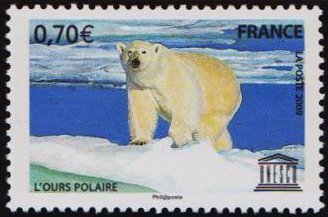Stamp: Polar Bear (Ursus maritimus) (France 2009)
Polar Bear (Ursus maritimus) (France 2009)
10 December (France ) within release Symbole de l'unesco goes into circulation Stamp Polar Bear (Ursus maritimus) face value 0.70 Euro
| Stamp Polar Bear (Ursus maritimus) in catalogues | |
|---|---|
| Yvert et Tellier: | Yt:FR SE144 |
| Michel: | Mi:FR U63 |
Stamp is square format.
|
Data entry completed
50%
|
|
|---|---|
| Stamp Polar Bear (Ursus maritimus) in digits | |
| Country: | France |
| Date: | 2009-12-10 |
| Print: | Offset and Lithography |
| Emission: | Official |
| Format: | Stamp |
| Face Value: | 0.70 Euro |
Stamp Polar Bear (Ursus maritimus) it reflects the thematic directions:
The United Nations Educational, Scientific and Cultural Organization (UNESCO; pronounced /juːˈnɛskoʊ/) is a specialized agency of the United Nations (UN) with the aim of promoting world peace and security through international cooperation in education, arts, sciences and culture. It has 194 member states and 12 associate members,as well as partners in the non-governmental, intergovernmental and private sector. Headquartered in Paris, France, UNESCO has 53 regional field offices and 199 national commissions
Bears are carnivoran mammals of the family Ursidae (/ˈɜːrsɪdiː, -daɪ/). They are classified as caniforms, or doglike carnivorans. Although only eight species of bears are extant, they are widespread, appearing in a wide variety of habitats throughout most of the Northern Hemisphere and partially in the Southern Hemisphere. Bears are found on the continents of North America, South America, and Eurasia. Common characteristics of modern bears include large bodies with stocky legs, long snouts, small rounded ears, shaggy hair, plantigrade paws with five nonretractile claws, and short tails.
The polar bear (Ursus maritimus) is a large bear native to the Arctic and nearby areas. It is closely related to the brown bear, and the two species can interbreed. The polar bear is the largest extant species of bear and land carnivore, with adult males weighing 300–800 kg (660–1,760 lb). The species is sexually dimorphic, as adult females are much smaller. The polar bear is white- or yellowish-furred with black skin and a thick layer of fat. It is more slender than the brown bear, with a narrower skull, longer neck and lower shoulder hump. Its teeth are sharper and more adapted to cutting meat. The paws are large and allow the bear to walk on ice and paddle in the water.
Animals are multicellular, eukaryotic organisms of the kingdom Animalia (also called Metazoa). All animals are motile, meaning they can move spontaneously and independently, at some point in their lives. Their body plan eventually becomes fixed as they develop, although some undergo a process of metamorphosis later on in their lives. All animals are heterotrophs: they must ingest other organisms or their products for sustenance.



